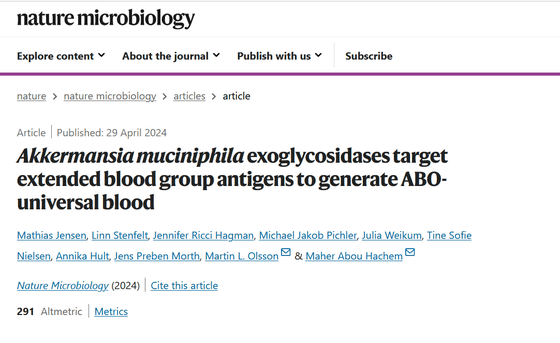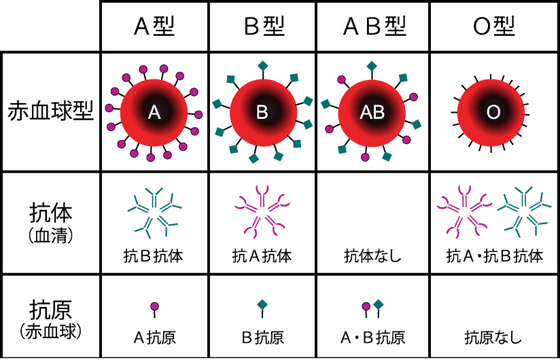Discovery of enzyme paves the way for universal blood products that can be transfused to any blood type

In medical settings, blood is classified into four types according to the ABO blood group system, which is a system in which blood is grouped into four types according to antigens, because incompatibility of blood during transfusion can be life-threatening. A research team from the Technical University of Denmark and Lund University announced that they have discovered an enzyme that can create a 'universal blood product' that can solve this problem of blood transfusion.
Akkermansia muciniphila exoglycosidases target extended blood group antigens to generate ABO-universal blood | Nature Microbiology

Enzymes open new path to universal donor blood
https://www.dtu.dk/english/newsarchive/2024/04/enzymes-open-new-path-to-universal-donor-blood
The ABO blood type system is a blood classification method discovered in 1900 by Austrian pathologists Karl Rann and Steiner, which divides blood into four types based on the 'antigens' and 'antibodies' present in the blood. For example, a person with blood type A has 'type A antigens' and 'anti-B antibodies,' while a person with blood type B has 'type B antigens' and 'anti-A antibodies.' If a person with type A receives a transfusion of type B blood, the 'type B antigens in type B blood' will react with the 'anti-B antibodies in type A blood,' causing the blood cells to clump or be destroyed, which can be life-threatening.

These antigens are classified according to the
A team of researchers from the Technical University of Denmark and Lund University focused on an enzyme from the intestinal bacteria Akkermansia muciniphila that breaks down the mucus that covers the mucus membrane of the intestine. Because the sugar structure of the mucus that covers the mucus membrane of the intestine was similar to the sugar chain structure on the surface of red blood cells, the research team thought that this enzyme could be used to break down the sugar chains of antigens.
Therefore, the research team conducted experiments using 24 types of enzymes obtained from Akkermansia muciniphila and hundreds of blood samples of types A and B. As a result, it was found that by combining some enzymes, it is possible to efficiently remove the glycan ends of blood types A and B. Furthermore, the combination of enzymes discovered in this study was successful in removing type A and type B antigens from blood that does not fall into the ABO blood type system, which was not previously recognized.

By using this enzyme, it will be possible to prepare a universal blood product that can be used for component transfusion regardless of blood type, improving the safety of blood transfusion and preventing accidents caused by ABO incompatibility transfusion. It is also expected that the transportation and management of blood products will be simplified and the amount of blood discarded will be reduced.
According to the research team, at the time of writing, it is possible to produce a nearly universal blood product from type B blood, but there are still challenges to be overcome in producing it from type A blood. The research team has applied for a patent for this new enzyme and processing method, and aims to make further progress in the next three and a half years of joint projects.
Related Posts:
in Science, Posted by log1i_yk







